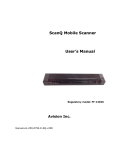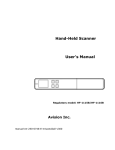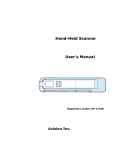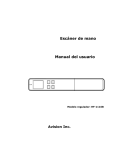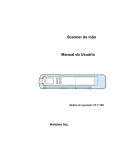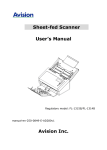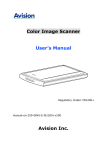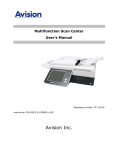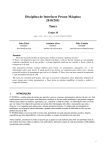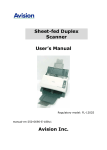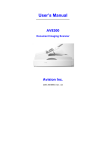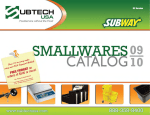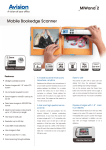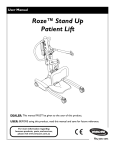Download Mobile Scanner User`s Manual
Transcript
Mobile Scanner User’s Manual Regulatory model: FF-1301S Avision Inc. manual-en-250-0828-E-micube-v200 Trademarks Microsoft is a U.S. registered trademark of Microsoft Corporation. Windows, Windows XP, Windows Vista, Windows 7 and Windows 8 are either registered trademarks or trademarks of Microsoft Corporation in the United States and/or other countries. IBM, IBM PC are registered trademarks of International Business Machines Corp. Other brands and product names herein are trademarks or registered trademarks of their respective holders. Copyright All rights reserved. No part of this publication may be reproduced, transmitted, transcribed, stored in a retrieval system, or translated into any language or computer language, in any form or by any means, electronic, mechanical, magnetic, optical, chemical, manual, or otherwise, without the prior written permission of Avision Inc. Material scanned by this product may be protected by governmental laws and other regulations, such as copyright laws, the customer is solely responsible for complying with all such laws and regulations. Warranty The information contained in this document is subject to change without notice. Avision makes no warranty of any kind with regard to this material, including, but not limited to, the implied warranties of fitness for a particular purpose. Avision shall not be liable for errors contained herein or for incidental or consequential damages in connection with the furnishing, performance, or use of this material. Disposal of Waste Equipment by Users in Private Union This symbol on the product or on its packaging indicates that the product can not be disposed of with your other household waste. Instead it should be sent to appropriate facilities for recovery and recycling in an effort to protect human health and the environment. Fore more information about where you can drop off your waste equipment for recycling, please contact your local city office, your household waste disposal service or the shop where you purchased the product. ii User’s Manual FCC Statement: This equipment has been tested and found to comply with the limits for a Class B digital device, pursuant to Part 15 of the FCC Rules. These limits are designed to provide reasonable protection against harmful interference in a residential installation. This equipment generates, uses and can radiate radio frequency energy and, if not installed and used in accordance with the instructions, may cause harmful interference to radio communications. However, there is no guarantee that interference will not occur in a particular installation. If this equipment does cause harmful interference to radio or television reception, which can be determined by turning the equipment off and on, the user is encouraged to try to correct the interference by one of the following measures: Reorient or relocate the receiving antenna. Increase the separation between the equipment and receiver. Connect the equipment into an outlet on a circuit different from that to which the receiver is connected. Consult the dealer or an experienced radio/TV technician for help. This device complies with Part 15 of the FCC Rules. Operation is subject to the following two conditions: (1) This device may not cause harmful interference, and (2) this device must accept any interference received, including interference that may cause undesired operation. European Union Regulatory Notice Products bearing the CE marking comply with the following EU Directives: Low Voltage Directive 2006/95/EC EMC Directive 2004/108/EC Restriction of the use of certain hazardous substances (RoHS) Directive 2011/65/EU CE compliance of this product is valid if powered with the correct CE-marked AC adapter provided by Avision. This product satisfies the Class B limits of EN55022, EN55024, safety requirements of EN 60950 and ROHS requirements of EN50581. *This machine is certified as Class 1 LED product. iii Warning and Precautions of the lithium-ion battery Warning: Danger warning to prevent the possibility of the battery from leaking, heating, explosion, please observe the following precautions: Don’t immerse the battery in water and seawater. Please put it in cool and dry environment if no using. Do not discard or leave the battery near a heat source as fire or heater Being charged, using the battery charger specifically for that purpose Don’t reverse the positive and negative terminals Don’t connect the battery to an electrical outlet directly. Don’t connect the positive and negative terminal directly with metal objects such as wire. Short terminals of battery is strictly prohibited, it may damage battery. Do not transport and store the battery together with metal objects such as necklaces, hairpins. Do not strike, throw or trample the battery. Do not directly solder the battery and pierce the battery with a nail or other sharp object. Do not use lithium ion battery and others different lithium polymer battery model in mixture. Prohibition of use of damaged cells. Don’t bend or fold sealing edge. Don’t open or deform folding edge. Don’t fillet the end of the folding edge. Don’t fall, hit, bend battery body. Battery pack designing and packing Prohibition injury batteries. Never disassemble the cells. Keep the battery away from babies. Any components contacting these two edges, they must be insulated. iv User’s Manual Caution: Risk of explosion if battery is replaced by an incorrect type. Dispose the battery according to local regulations. Never place batteries or devices on or in heating devices, such as microwave ovens, stoves, or radiators. Batteries may explode when overheated or its performance will be degenerate and its service life will be decreased. Do not use it in a location where is electrostatic and magnetic greatly, otherwise, the safety devices may be damaged, causing hidden trouble of safety. If the battery leaks, and the electrolyte get into the eyes. Do not wipe eyes, instead, rinse the eyes with clean running water, and immediately seek medical attention. Otherwise, eyes injury can result. If the battery gives off an odor, generates heat, becomes discolored or deformed, or in any way appear abnormal during use, recharging or storage, immediately remove it from the device or battery charge and stop using it. Avoid charging batteries for more than a week, as overcharging may shorten battery life. Over time, unused batteries will discharge and must be recharged before use. Disconnect chargers from power sources when not in use. Use batteries only for their intended purposes. Store the battery at 0°C to 40°C. Avoid exposing your device and batteries to very cold or very hot temperatures. Extreme temperatures can cause the deformation of the device and reduce the charging capacity and life of your device and batteries. Prevent batteries from contacting metal objects, as this can create a connection between the + and – terminals of your batteries and lead to temporary or permanent battery damage. In case the battery terminals are dirt, clean the terminals with a dry cloth before use. Otherwise power failure or charge failure may occur due to the poor connection with the instrument. Be aware discharged batteries may cause fire. Follow all local regulations when disposing of used batteries or devices. Never crush or puncture the battery. Avoid exposing the battery to high external pressure, which can lead to an internal short circuit and overheating. v Table of Contents 1. Overview ........................................................................... 1-1 1.1 1.2 1.3 1.4 1.5 1.6 2. Installation ........................................................................ 2-1 2.1 2.2 2.3 2.4 2.5 3. Clean the Scanner Glass, Separation Pad and Rollers ............................ 4-1 Calibrate the Scanner ....................................................................... 4-3 Replace the Feed Roller .................................................................... 4-5 Replace the Separation Pad............................................................... 4-8 Troubleshooting................................................................. 5-1 5.1 5.2 5.3 5.4 6. Suitable and Unsuitable Original Types ............................................... 3-1 Power on the Scanner ...................................................................... 3-2 Choose Your Desired Scan Settings .................................................... 3-2 Load a document ............................................................................. 3-3 Start a scan .................................................................................... 3-4 Scan a card .................................................................................... 3-5 Scan dark pictures ........................................................................... 3-6 Power off the Scanner ...................................................................... 3-7 View or Download the Scanned Images (Windows) ............................... 3-7 3.9.1 Computer system requirements .............................................. 3-8 3.9.2 Connect with Windows XP or Later .......................................... 3-8 3.9.3 Connect with Macintosh computer ........................................... 3-8 3.9.4 Access your scanned images .................................................. 3-8 3.9.5 Disconnect the scanner ......................................................... 3-9 Maintenance ...................................................................... 4-1 4.1 4.2 4.3 4.4 5. Precautions..................................................................................... 2-1 Install the Batteries ......................................................................... 2-1 Charge the Batteries ........................................................................ 2-3 2.3.1 Via the USB Cable................................................................. 2-3 2.3.2 Via the USB Power Adapter .................................................... 2-4 Install a SD Card ............................................................................. 2-5 Install the Feed Extension Plate ......................................................... 2-6 Operation........................................................................... 3-1 3.1 3.2 3.3 3.4 3.5 3.6 3.7 3.8 3.9 4. Introduction.................................................................................... 1-1 Package Contents ............................................................................ 1-1 Front View ...................................................................................... 1-3 Rear View ....................................................................................... 1-5 Side View ....................................................................................... 1-5 LCD Display .................................................................................... 1-6 Clear a paper jam ............................................................................ 5-1 Error Conditions .............................................................................. 5-2 Frequently asked questions and answers............................................. 5-3 Technical Service ............................................................................. 5-6 Specifications .................................................................... 6-1 vi User’s Manual 1. 1.1 Overview Introduction Congratulations on your purchase of the portable scanner. With this scanner, you can scan and store your multi-page documents directly to a SD card without any computer. Simply turn on the scanner, and press the Scan button to start a scan. The scanned image is stored on the scanner’s built-in disk (automatic if no memory card is inserted), or you can insert a memory card for expanded storage capacity. Before you install and operate the product, please take a few minutes to read through this manual. It provides proper instructions for you to install, operate and maintain the product. The following figure indicates the package contents. Please check all the items against your checklist. If you do not receive all the items, please contact your authorized local dealer immediately. 1.2 Package Contents Scanner Quick Guide Li-Ion Battery Carry Bag USB Cable Software CD microSDTM Card (User’s Manual) Calibration Sheet Cleaning Cloth Online Registration Notice USB Power Adapter 1-1 Note: 1. Only use the USB adapter (DSC-5CU-05 050100 made by DVE) and the Li-ion Battery AP-120 made by APACK/CB-PD(NP-120) made by City Bright included in the product. Using other power adapters may damage the machine and void the warranty. 2. Please unpack the packing carefully, and check the contents against the checklist. If any items are missing or damaged, please contact your dealer immediately. 1-2 User’s Manual 1.3 Front View 1 2 3 4 7 Item 1 Name 6 5 Description LCD display Displays the battery status and current scan settings. Indicates the operating/warning status of the scanner. Solidly lit in green color: The power is turned on. System indicator light 2 Flashing in green color: Scanning a document in 300 dpi. Flashing in orange color: Scanning a document in 600 dpi. Flashing in red color: Paper is jammed. A double feed has been detected and the scanner has stopped. The top unit is open. Another scanner error has occurred. 3 Scan 4 JPEG/ PDF 5 300/ 600 dpi Press to switch to 300 dpi or 600 dpi. 6 Color/ B&W Press to switch to Color or B&W mode. 7 Feed tray Press to start a scan. Press to switch to JPEG or PDF file format. This tray is used for feeding documents. Open it when scanning documents. 1-3 1 2 2 3 Item 1 2 3 Name Document Extension Plate Document Guides Feeder Cover Description Open the plate to support the document when loading a long document. These guides ensure documents are fed straight. Raise the guides when loading a document, and then align them to the edges of the document to be scanned. Open this when cleaning the scanner. 1-4 User’s Manual 1.4 Rear View 1 Item 1.5 2 Name Description 1 Plastic card feeder Used to insert and hold a business card or a plastic card. 2 Memory card slot Used to insert a memory card. Side View 1 Item 2 Name Description 1 Power switch Turn to the [ON] position to power on the scanner or turn to the [OFF] position to power off the scanner. 2 Micro USB port Used to plug the micro end of the USB cable to connect to PC. 1-5 1.6 LCD Display Item 4 1 5 2 6 3 Name Description 1 Battery status Indicates the power status of the battery. 2 Scan count Indicates scan count. 3 File format Indicates current file format for the scanned image. Choice: PDF, JPEG. 4 Color mode Indicates current color mode. Choice: Color, Black and White. 5 Memory card Indicates an inserted memory card. 6 Resolution Indicates current resolution. Choice: 300 dpi, 600 dpi. 1-6 User’s Manual 2. Installation 2.1 Precautions Keep the product out of direct sunlight. Direct exposure to the sun or excessive heat may cause damage to the unit. Do not install the product in a humid or dusty place. Place the product securely on an even, flat surface. Tilted or uneven surfaces may cause mechanical or paper-feeding problems. Retain the product box and packing materials for shipping purposes. 2.2 Install the Batteries 1. Open the feed tray. 2. Open the feeder cover. 2-1 3. Open the battery cover. 2-2 User’s Manual 4. Load the battery into the battery container. Make sure the battery is loaded with the correct polarity. Note the copper strips on the battery should be touching the copper strips on the device. Note: Please use only the supplied battery. 5. Close the battery cover and feeder cover. 2.3 Charge the Batteries There are two methods to charge the batteries, a. Through the USB cable to the computer. b. Through the USB power adapter to the electric outlet. 2.3.1 Via the USB Cable 1. Turn off the scanner. 2. Connect the micro USB connector to the USB port of the scanner. 3. Connect the other USB connector to the USB port on your computer. 2-3 2.3.2 Via the USB Power Adapter 1. Turn off the scanner. 2. Connect the micro USB connector to the USB port of the scanner. 3. Connect the other USB connector to the USB port of the USB Power Adapter. USB Power Adapter Important: For first-time use, please charge the battery for at least 4 hours. While charging the battery, the blue LED light will be solidly on. After the charging is completed, the LED light will be extinguished. When the battery is fully charged, an A4-sized of page can be scanned for 200 times at 300 dpi (or 150 times at 600 dpi)! 2-4 User’s Manual 2.4 Install a SD Card The scanner’s built-in storage disk has approximately 128MB of space that can be used to store scanned images. You can install a SD card to the SD slot of the scanner to expand your storage. Gently press in until the SD card is latched. Note: The scanner only accepts SD card in FAT16 or FAT32 format. NTFS and other file formats are not supported. 2-5 2.5 Install the Feed Extension Plate 1. Open the feed tray. 2. Open the feed extension plate. 2-6 User’s Manual 3. Raise the right and left document guides to load your document. 2-7 User’s Manual 3. Operation 3.1 Suitable and Unsuitable Original Types Suitable Original Types The scanner used with the feeder dock is designed to obtain the best scanning results with the following types of originals: Photos and documents (3”x5”, 4”x6”, 5”x7”, 8.5”x14”) (76 x 127mm, 102 x 152 mm, 127 x 177 mm, 216 x 356 mm) Business cards [standard 3.5” x 2” (88 x 50 mm) or larger] Document weight: 60 ~ 107 g/m² (16 to 28 lb) Long Page (216 x 916 mm) (available for 300 DPI only) Unsuitable Original Types Do not use the following types of originals for scanning in the feeder dock, otherwise the feeder dock may malfunction or cause the original to jam in the slot. Originals thicker than 0.76 mm Original with either side shorter than 50 mm Originals with lots of black or dark colors Original with dark colors surrounding the edges Printed media (newspapers, magazines, etc Soft and thin materials (thin paper, cloth, etc.) Curl or wrinkle originals Originals with staples or paper clips. Originals that exceed acceptable size – 8.5” (width) x 14”(length) (216 x 356 mm) (in 600 dpi) 3-1 3.2 Power on the Scanner Turn the Power Switch to the [ON] position to turn on the scanner. The LED indicator light will be lit and the default scan settings will be displayed on the LCD screen. 3.3 Choose Your Desired Scan Settings After the scanner is turned on, the LCD displays the default scan settings, Resolution: 300 dpi, Color mode: color, File format: JPG. Color Mode (Color/BW) The scanner offers two color modes for your scanned image, Color (default, fits for photos) and Black and White (fits for text document). Press [Color/BW] to switch to BW mode. Save Format (JPEG/PDF) Resolution (300/600) The scanner offers two types of file formats for your scanned image, JPEG (default, fits for photos) and PDF (fits for text document). Press [JPEG/PDF] to switch to PDF file. The scan resolution is measured in dpi (dots per inch). The higher the resolution, the more details the scanned image will be displayed. However, a higher resolution may require more disk space stored in the SD card. The scanner offers two types of resolution, 300 dpi (default, fits for most document) and 600 dpi (higher resolution). Press [300/600 dpi] to switch to 600 dpi. 3-2 User’s Manual 3.4 Load a document Fanning Your Document Standard paper size should feed easily through the scanner. To avoid occasional paper jam when automatically feeding multiple documents, loosen the paper before loading. Document Feeding 1. Load the stack of document FACE DOWN with the top of the pages pointing into the feeder. Up to 8 pages of plain paper can be loaded at one time in the feeder. 2. Make sure the document guides are aligned with the edges of the stack. 3-3 3.5 Start a scan Press the [Scan] button to start a scan and the paper will feed through the scanner. 3-4 User’s Manual 3.6 Scan a card 1. Make sure the feeder cover and paper tray are closed as shown. 2. Insert your plastic card FACE DOWN, TOP EDGE FIRST into the scanner’s feeding slot for cards at the back of the scanner, align it to the left edge of the slot (), and gently push the card into the feeding slot () as indicated. 3. As long as the card is properly inserted into the feeder, the scan will be started automatically. 3-5 3.7 Scan dark pictures The scanner has a built-in cropping function that automatically detects and crops dark edges and dark areas against the cropping baseline background during the scan process. To prevent poor cropping, align the original straight against paper guides and ensure there is adequate space in front of the feeder for the originals to completely feed through. Scanning on a flat and uncluttered surface is recommended. The following example illustrates a 4”x6” original photo scanned with auto-crop: Original/Auto-crop on (default) If the original is fed slightly crooked, the original is only cropped a pre-defined maximum amount, as shown in the following illustration: Max. 1.5mm Max. 1.5mm 3-6 User’s Manual 3.8 Power off the Scanner When your scanning job is completed, move the Power switch to the [OFF] position to turn off the scanner. The LCD display will be off. When the scanner is left idle for 3 minutes, the default Power Save mode automatically powers off the scanner. 3.9 View or Download the Scanned Images (Windows) Connect the scanner to your computer to access the scanned images from the scanner’s built-in disk or from the inserted memory card without using an independent card reader. While connected, you can view your scanned image files, copy and paste files from one storage area to the other, or delete files you don’t wish to keep. 3-7 3.9.1 Computer system requirements Operating System: Windows – XP, Vista, Windows 7, Windows 8 Macintosh – Mac OS 10.5, 10.6, or later USB Port: USB 2.0 3.9.2 Connect with Windows XP or Later 1. Turn on the scanner. 2. Insert the memory card containing your scanned images into the scanner’s memory card slot. Skip this step if images are stored on the built-in disk. 3. Connect the included USB cable to the scanner and to your computer. 4. Your computer should recognize the card or the scanner as a Removable Disk. 5. Click the Removable Disk and you will find a folder of “DCIM” is created and all the PDF files will be stored in the subfolder of “200DOC” and the JPEG files in the subfolder of “100PHOTO”. File name starts from IMG_0001.pdf or IMG_0001.jpg. 3.9.3 Connect with Macintosh computer When the computer recognizes the scanner built-in disk or inserted memory card, the volume icon appears on the desktop. To view the contents of the built-in disk or memory card, double-click the icon to open a Finders window. 3.9.4 Access your scanned images Each scanned image is given a file name with the prefix IMG_ followed by a 4-digit sequential number in the order the images are stored. For example, IMG_0001.jpg, IMG_0002.jpg, IMG_0001.pdf, IMG_0002.pdf, etc. JPG files are stored in a sub folder titled DCIM\100PHOTO. The folder stores 9999 photo files, and then automatically creates another sub folder titled 101PHOTO, and so on to 199PHOTO. PDF files are stored in a sub folder titled DCIM\200DOC. The folder stores 9999 document files, and then automatically creates another sub folder titled 201DOC, and so on to 299DOC. 3-8 User’s Manual 3.9.5 Disconnect the scanner CAUTION: Do not remove the memory card or disconnect the USB cable while the computer is accessing stored files. Disconnect the Scanner from a Windows PC 1. On the Windows System Tray, click the hardware removal icon as indicated below. 2. Click Safely remove USB mass Storage device – Drive (<Drive Letter:>) 3. When the Safe to Remove Hardware message appears, you can safely remove the scanner’s USB cable. Disconnect the Scanner from a Macintosh 1. Click and drag the volume icon on the desktop to Trash. Or Click the eject button next to the volume name in the Finder’s window. 2. Disconnect the scanner from your computer. 3-9 User’s Manual 4. 4.1 Maintenance Clean the Scanner Glass, Separation Pad and Rollers If the scanned images contain streaks or scanned documents become dirty, the scanning glass, separation pad and roller inside the scanner are likely to be dirty. Clean them periodically. Use only the recommended or supplied tool to clean the scanner and feeder dock. Cleaning steps: 1. Open the feed tray. 2. Open the feeder cover. 4-1 3. Wipe the separation pad, rollers and the glass with the included cleaning cloth. Note: Adding some isopropyl alcohol (95%) on the cleaning cloth is more efficient when cleaning the rollers. Do not use any solvents or corrosive liquid (i.e., alcohol, kerosene, etc.) to clean any part of the scanner, otherwise the plastic material will be permanently damaged. Make sure the surface of the document or photo doesn’t have any paper clips, etc. or this could damage the scanner glass lens. 4-2 User’s Manual 4.2 Calibrate the Scanner Calibrate only if the scanned image looks fuzzy, the color looks abnormal (e.g., darker than normal), after more than 8,000 scans, or the scanner has been stored without use for a long time. The calibration process resets the Contact Image Sensor to resume its color and sharpness precision. 1. Make sure the Document Guides are unfolded as indicated. 2. Turn on the scanner by moving the Power switch to the [ON] position. 3. Remove the calibration chart from the plastic bag and hold the edges of the calibration chart (included). Insert the chart with the text FACE DOWN, and the white area feeding first to the feeder as shown. 4-3 4. To enter the calibration mode, press and hold the [Color/BW] until [CAL] is displayed on the screen and the [Scan] LED flashes in green, indicating you are in calibration mode. 5. Press the [Scan] button. The calibration chart will be fed through. 6. After the calibration process is finished, [OK] will be displayed on the screen. Warning: If the calibration process failed, the Red LED will be flashing and [E19] will be displayed on the screen. Power off the scanner and then repeat the calibration step again. 7. The scanner returns to the ready status to proceed with normal use. Warning: Do not interrupt the calibration sequence or try to shut off the device while it is calibrating. If you stop the calibration before it has completed, a calibration error may occur. As a result, you will have to power off the unit and repeat the instructions in this section. Calibrate the scanner only when color of the scanned image looks abnormal. Keep the calibration sheet from dust and debris. Any dirt may make the calibration chart invalid or impact the calibration result. Use only the included calibration sheet to calibrate the scanner. 4-4 User’s Manual 4.3 Replace the Feed Roller The feed roller and separation pad inside the scanner wear with scanning. If the feed roller and separation pad are worn, documents may not feed correctly and paper jams may occur. When document feed performance deteriorates, replace the feed roller and separation pad.. Note: It is recommended to replace the feed roller or separation pad when the total number of pages of documents fed in the scanner exceeds one of the following quantities: Feed Roller: 100,000 sheets Separation Pad: 10,000 sheets Follow these steps to replace the separation pad and feed roller. To replace the Feed Roller, 1. Open the feed tray. 2. Open the feeder cover. 4-5 3. Open the roller cover. 4-6 User’s Manual 4. Slide the feed rollers to the right. 5. Remove the feed rollers. 6. Attach the feed rollers. Insert the left end of the shaft to the notch. A snap-in sound could be heard. 7. Completely close the roller cover so that it clicks into place. 8. Close the feeder cover. 4-7 4.4 Replace the Separation Pad To replace the Separation Pad, 1. Open the feed tray. 2. Open the feeder cover. 3. Press two arms of the separation pad inwardly with two fingers () and lift it up () to remove the separation pad. 4-8 User’s Manual 4. Hold two arms of the separation pad with two fingers and attach the new separation pad to the scanner. 5. Close the feeder cover. 4-9 User’s Manual 5. 5.1 Troubleshooting Clear a paper jam In the event of a paper jam, follow the procedures below to remove the paper: 1. Gently open the feeder cover. 2. Carefully pull the paper out of the feed tray. 3. Close the feeder cover. Your Scanner is now ready to use. 5-1 5.2 Error Conditions If there is error during scanning, the LED light will be flashing in red color and error codes will be displayed. Refer to the following table to clear the error conditions. Error Code/Meaning Cause How to restore E03 Storage error Storage is full; can not save image to storage device. Free more space or insert a new SD card. Storage device not recognized. Format your storage device. 1. Original has become stuck in the feeder. Open the feeder cover and pull the original out of the feeder. E04 Paper jam 2. Original exceeds max. length [300 dpi: 36” (914mm), 600 dpi: 14” (356mm)] E05 No scan data detected. Wait until error disappears. Feeder cover opens. Close the feeder cover. E08 Low battery Battery power getting low. Recharge the battery. E19 Internal check failed and found calibration data error Recalibrate the scanner (see the “Calibrate Scanner” section. No image scanned E06 Cover opens Calibration Fails * Warning: If "low battery" is indicated on the LCD display, it is recommended to recharge the battery to prevent possible incomplete scanned images or other operational problems. 5-2 User’s Manual 5.3 Frequently asked questions and answers Q: Paper becomes jammed or multi-fed. A: 1. Flatten the corners and edges of your documents. 2. Thoroughly fan your documents before loading them into the scanner. Document might stick together because of static electricity. 3. Reduce the number of pages that you load into the scanner at one time. Q: A: Paper becomes skewed in the scanner. 1. Align the document guides to fit the documents as closely as possibly and place the documents so that they feed in straight. 2. Check the condition of the feeding roller. If necessary, follow the cleaning directions in Section 5.1 and perform the cleaning. Q: Why does not my scanner turn on? A: The batteries may not enough power or may not be inserted correctly. Q: The image can not be saved into the memory card while scanning? A: Make sure you have a SD card inserted correctly, and that it has adequate space. Q: Why doesn’t my computer recognize my scanner when it’s connected via USB cable? A: Make sure the cable connection is correct and secure. Restart the computer if necessary. 5-3 Q: A: Why there are strange lines on the scanned document? Please check the following: 1. Are there scratches on the original or is the original clean? 2. Remove any stains or dust from the original before scanning. 3. Clean the rollers and glass with the included cleaning cloth. (Refer to the section “Cleaning the Rollers and Glass)) Q: Will the scanner recharge my rechargeable batteries? A: No, the scanner does NOT recharge rechargeable batteries. You must use your own battery charging device. Q: Why there is a red or gray background with lines on my scanned image? A: The scanner does not enough power to perform a scan. Charge your batteries and restart the scan. Q: Should the scanner feel warm to the touch? A: It is normal for the scanner to emit a small amount of heat after prolonged use. However, if there are strange odors coming from the scanner or the scanner feels a little bit hot to the touch, turn the scanner off immediately. 5-4 User’s Manual Q: Why do all the images I scanned have the same date when saved on the memory card? Is it possible to show real time for these images? A: Yes. Please follow these steps to set a real-time clock for the device: 1. Open your browser and type Avision’s web site (http://www.avision.com) at the URL address. On the Product or Support page, select this mobile scanner and then download a time.txt file for the device. 2. Make sure your scanner is inserted with a SD card and a battery full of power. 3. Turn on your scanner and connect it to your computer with a USB cable. Your computer should recognize the scanner as a Removable Disk. 4. Copy and paste the time.txt file to the root directory of the Removable Disk Drive. 5. Open the text file. The text file contains a string in YYYY/MM/DD/HH/MM format which indicates year(4digit)/month(2-digit)/date(2-digit)/hour(2-digit)/minute(2digit), for example, 2013/06/15/07/30. 6. Change the date and time to correct values and then save the file. 7. Turn off the scanner and then turn it on. Now your have completed setting the real-time clock for the device. Scan a document and save the image to the memory card. Connect the scanner to your computer, you will find the scanned images are displayed with correct date and time. Note: Charge your battery when its power is running low. If the battery has been replaced or the battery has no power at all, you will need to recharge the battery and repeat the above steps to set a real-time clock again. 5-5 5.4 Technical Service Before contact Avision, please prepare the following information: Scanner serial & revision number (located on the bottom of the scanner); Hardware configuration (e.g., your host CPU type, RAM size, free disk space, display card, interface card); Headquarter Avision Inc. No. 20, Creation Road I, Science-Based Industrial Park, Hsinchu 300, Taiwan, ROC TEL: +886 (3) 578-2388 Toll Free: 0800-600-785 FAX: +886 (3) 577-7017 E-MAIL: [email protected] Web Site: http://www.avision.com.tw US and Canada Area Avision Labs, Inc. 6815 Mowry Ave., Newark CA 94560, USA TEL: +1 (510) 739-2369 Toll Free: 1-888-909-7888 FAX: +1 (510) 739-6060 E-MAIL: [email protected] Web Site: http://www.avision.com China Area Avision(Suzhou) Co., Ltd. No.9, Suhong West Road, Suzhou Industrial Park, Jiangsu Province, PRC 215021 TEL:+86-512-62565888 Toll Free:+86-400-185-8566 FAX:+86-512-62560115 E-MAIL:[email protected] Web Site:http://www.avision.com Europe Area Avision Europe GmbH Bischofstr. 101 D-47809 Krefeld Germany TEL: +49-2151-56981-40 FAX: +49-2151-56981-42 E-MAIL: [email protected] Web Site: http://www.avision.de 5-6 User’s Manual South American Area Avision Brasil Ltda. Rua Bamboré 41, Vila Monumento, Ipiranga. CEP: 04278-060, São Paulo, Brasil TEL: +55-11-2737-2005 E-MAIL: [email protected] Web Site: http://www.avisionbrasil.com.br/ 5-7 User’s Manual 6. Specifications Specifications are subject to change without notice. General Specifications: Item Description Regulatory model number FF-1301S Image Technology Contact Image Sensor (CIS) Built-In Memory 128M Scanner Display 1.2” TSN LCD Max. Document Size 8.5” x 14” (216 x 356 mm) Long Page Mode 36” (Available for 300 dpi only) Min. Document Size 3.5” x 2” (88 x 50 mm) Document Weight 60 ~ 107 g/m² ( 16 to 28 lb ) Card Weight <0.76mm Auto power off 3 minutes Output File Format JPEG/PDF Resolution 300 dpi /600 dpi ADF Capacity 8 pages Support Operating System Windows XP / Vista / 7 /8, Mac OS 10.5 or later Interfaces Memory Card SD card USB Micro USB port compatible with the USB 2.0 USB Power 5Vdc, 500mA Battery Rechargeable Li-ion battery AP-120 (APACK)/CB-PD(NP-120) (City Bright) 3.7V, 1700mAh Battery Life 200 pages (A4, Color, 300 dpi) Net Weight 800 g (1.8 lb) Dimensions(WxLxH) 11.6” x 3.2” x 1.6” (295 x 81 x 41 mm) Operating Environment Temperature:10ºC ~ 35ºC (50ºF~95ºF) Humidity: 10%~85% RH 6-1















































